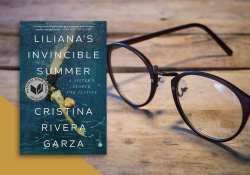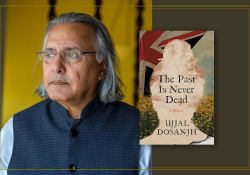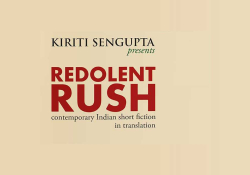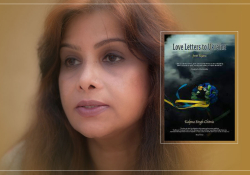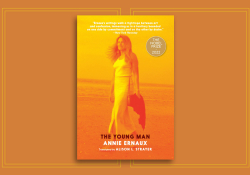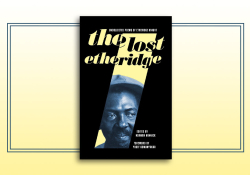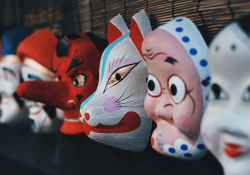Grimm Beginnings

A review of The Original Folk and Fairy Tales of the Brothers Grimm: The Complete First Edition, by Jacob and Wilhelm Grimm, trans. Jack Zipes, illus. Andrea Dezsö (Princeton: Princeton University Press, 2014), and Grimm Legacies: The Magic Spell of the Grimms’ Folk and Fairy Tales, by Jack Zipes (Princeton: Princeton University Press, 2015).
Jacob and Wilhelm Grimm were heroic scholars. Each graduated at the head of his class at the Lyzeum in Kassel. Jacob became a royal diplomat. They throve as royal librarians, working closely together throughout their careers. In the hope their work would help unify hundreds of petty states into a single self-conscious Germany, they gave Germans a German grammar and dictionary, studies of German legends and myths, and a survey of German law. They gave the world Grimms’ Fairy Tales.
In 1812 they wrote, “The custom of story-telling is so marvelous, and it is just what this poetic art has in common with everything eternal.” Altogether marvelous are the tales of the Brothers Grimm. Among talking foxes and clever elves come Jesus and the Virgin mother, the Devil and his grandmother, cannibal kings, abandoned babies, a churl who beheads a unicorn, children who kill children, and women beaten, butchered, and burned alive. How did this all come together and spread so far?
In 1812 and 1815 the Grimms published the first edition of their Kinder- und Hausmärchen in two volumes, a collection of 157 tales. Through six later editions the Grimms revised their collection substantially, dropping and adding tales toward a total of 210. Not every tale they collected made it into their collections. Heinz Rölleke observed that “the Grimms were from the beginning only interested in texts that were well told, artistically appealing, and free of obscenity and class hatred.”[1]
Jack Zipes’s new translation, The Original Folk and Fairy Tales of the Brothers Grimm: The Complete First Edition (hereafter, the First Edition), presents the ancestor of the Grimms’ seven editions, tales they assembled in the turmoil of Napoleon’s wars. From the first, their tales are full of war. Zipes believes “many of the tales in the first edition are more fabulous and baffling than those refined versions in the final version. . . . These tales are fascinating because they bear the imprint of their informants and are largely unknown to the general public.” “Largely unknown” because the Grimms later removed tales from the First Edition.
So did English translators.
In their preface, the Grimms praise the Reinheit, the purity, gleaming through the tales. They compare their tales to the “sky blue, flawless, shining eyes” of children. They admire “the fool, mocked and neglected by everyone” who “gains happiness only because of his pure heart.”
So did English translators.
English Translations of Grimms’ Fairy Tales
The first English collections of Grimms’ tales were translated by Edgar Taylor in two volumes (1823 and 1826). His translations, often reprinted, are available through Kindle. His translation is a free and friendly one, retelling tales for the English tastes. Taylor took many liberties and set several precedents for later English Grimms’: his collection was incomplete, including only 56 of the Grimms’ tales;[2] he rearranged the order; he altered and edited out episodes and characters; he mingled others’ tales with the Grimms’.
Observing “the scrupulous fastidiousness of modern taste,” Taylor chose tales that became favorites: versions of “Snow White,” “Hansel and Gretel,” “Rumpelstiltskin,” and “Cinderella.” He also included the anti-Semitic “Jew in the Bush,” such was his modern taste.
Household Stories Collected by the Brothers Grimm, a popular anonymous translation, first appeared in 1857. It omitted tales because “English mothers might object.”
In her 1894 Grimm’s Fairy Tales (Grimm’s rather than Grimms’ is a common error), Sara E. Wiltse declared “Grimm’s Fairy Tales have been limited in their use for lack of the purifying and eliminating process undertaken in this volume. . . . evil motives, magic interposition in favor of idlers and tricksters, cruel step-mothers and unnatural fathers are entirely excluded, the editor having taken full liberty in bringing about certain changes in phrase or plot that were needed to preserve the eternal spirit of love and justice which has been too long buried under the transient forms of many of the classic fairy tales.”[3]
It is against this bleaching tide that Zipes has worked for decades.
“Complete” Grimms’ Fairy Tales
Mrs. Henry H. B. Paull’s Grimms’ Fairy Tales of 1872 claimed to be “a complete translation” yet included only 128 tales, and these, like so many before, were adaptations rather than translations.[4] The first full and reliable English translation was Margaret Hunt’s Grimm’s Household Tales in 1884. It is the one and only translation that also translates the Grimms’ scholarly notes. Hunt’s translation superseded all others and is still in print with Pantheon and Barnes & Noble; in shame, those editions forget the notes and erase her name. Ralph Manheim translated 210 tales for his Grimms’ Tales for Young and Old (Doubleday, 1977), a translation Zipes calls “excellent.” Francis P. Magoun Jr. and Alexander Krappe translated all 210 for their Grimms’ German Folk Tales (Southern Illinois University Press, 1960). Zipes did better than that.
Zipes’s Complete Fairy Tales of the Brothers Grimm (Bantam Books, 1987; hereafter Complete Grimms) became “more complete” in the second edition (1992) and “even more complete” in the third (2003). In fidelity and completeness, Zipes’s third edition is the best Complete Grimms in print, a translation that makes a happy companion to Heinz Rölleke’s superb German editions. It opens with a bravura introduction, includes all 210 tales of the Grimms’ seventh and last edition, and adds tales the Grimms published elsewhere. It reproduces most of John Gruelle’s 1914 illustrations and includes source notes and a title index. It has 27 fables that disappeared in later editions—tales like “Puss in Boots,” “The Long Nose,” and “Bluebeard”—that might otherwise have made the First Edition more attractive and unique.
Grimms’ readers may inquire: If I have the third edition of Zipes’s Complete Grimms, why would I want the First Edition? What has it got the third edition has not?
Many things.
For anyone getting started with the Grimms, the First Edition is the runway. From the first the collection had versions of “Snow White,” “Hansel and Gretel,” “Rapunzel,” “Rumpelstiltskin,” “The Juniper Tree,” “Godfather Death,” and “Cinderella.”
There are tales in the First Edition that are not in Zipes’s Complete Grimms: “Hans’s Trina” (replaced in later versions by “Lazy Heinz”), “Johannes Waterspring and Caspar Waterspring” (replaced by “The Two Brothers”), “The Poor Maiden” (replaced by “The Star Coins”), and several more. In the First Edition the Grimms gave two versions of “Clever Hans” and two of “The Little Magic Table”: later editions had but one of each.
The first versions often differ much from their successors: they grow longer and more miraculous. Tales are tidied up, given happier endings. In the 1857 version of “The Godfather” the man escapes the Devil. In the First Edition the Devil has the last word.
Some tales in the First Edition are word-for-word identical with tales in Zipes’s Complete Grimms, but it is clear that Zipes revisited his prior translations. “Talers” become “gold coins.” The ditties in “Mrs. Fox” are redone; so are the two Kettenlieder, “Little Louse and Little Flea” and “The Pear Refused to Fall.”[5] Especially welcome are Zipes’s translations of the Grimms’ prefaces to the First Edition, twelve important pages absent in his Complete Grimms.
The First Edition tempts like the devil to read the tales again, gasp at their brazen heroes, and wander their forest paths.
The First Edition has twenty illustrations by Andrea Dezsö that stress the tales’ darkness and death. She illustrates tales like “Herr Fix-It-Up,” “How Some Children Played at Slaughtering,” “The Devil in the Green Coat,” and “Okerlo,” tales prior illustrators never knew. Princeton University Press’s editing, design, printing, and binding (sewn, not glued) produce a durable and attractive text well matched to Dezsö’s illustrations. The First Edition tempts like the devil to read the tales again, gasp at their brazen heroes, and wander their forest paths. The First Edition concludes with “The Golden Key,” as it should, a finely cut twenty-four-carat prism.
Zipes adds notes based on the Grimms’ annotations. Like their notes, his provide sources and occasional variants. No less than the tales, the annotations are what earned the Grimms worldwide admiration. Without the Grimms’ annotations, Complete Grimms are incomplete.
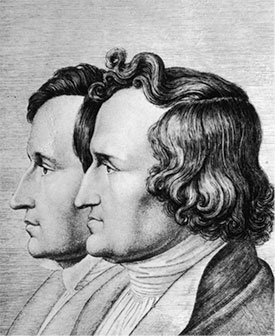
by their younger brother, Ludwig Emil Grimm.
The Grimms of Grimms
Zipes likes the tales of Basile, Perrault, and Hans Christian Andersen well enough, but his heart belongs to the Grimms. For years he has been the primary importer of German Grimm scholarship into English. His Complete Grimms is a monumental achievement, yet big as it is, Zipes reminds readers that the tales are only part of the Grimms’ nationalizing project, only one reason to continue paying attention to them.
Grimm Legacies collects six talks Zipes delivered at conferences commemorating the bicentennial of the first edition. Revised for publication, the talks relate what became of the tales after the Grimms returned to the earth. The talks are published in time to accompany the First Edition like well-groomed ushers before a bride. Zipes’s prose is again clear, precise, discreet, and exceedingly well informed about scholarship on the Grimms. He again tackles interesting questions. “Have the Grimms’ original intentions been betrayed? Did they betray them?”
Zipes defends “the Grimms’ tales” as if they’ve been trespassed and vandalized, shooing away poachers and wolves, now and then taking a shot.
Zipes answers: yes and no, as he separates the legacies from the travesties. He updates his take on the “German obsession” for the Grimms. He gives the notion of “legacy” a good shaking. Like the Brothers, he is of two minds: he grouses about “kitsch uses of the Grimms’ tales,” according them property rights, yet says “the tales never belonged to the informants or to the Grimms.” Zipes defends “the Grimms’ tales” as if they’ve been trespassed and vandalized, shooing away poachers and wolves, now and then taking a shot.
Zipes sheds any pretense of the neutral observer. He confidently distinguishes between “valid and invalid” appropriations of the Grimms, he dares to write “authentic,” and he cheerfully champions “the genuine cultural heritage of Germany.” No better way to recover that heritage than with a pair of Grimms.
Zipes shows what the Grimms learned from Edgar Taylor’s English versions: how to make the tales more suitable for children. The Brothers reduced and repacked their collection in the kleine Ausgabe (small editions), illustrated books of only fifty tales. The offshoot quickly obscured the parent. “In no way, despite the Grimms’ creation of the Small Edition in 1826, did they want their German tales to be treated as tales for children. . . . Yet, this is exactly what happened.”[6] Big editions were shoved into the shade by little ones.
Zipes praises twenty-first-century works that “represent significant artistic contributions to our understanding of the Grimms’ folk and fairy tales.”[7] He curtly condemns the works he dislikes, saving space for recommendations. He is fond of Ann Sexton’s Transformations (1971). He likes Sondheim’s Into the Woods (1986). Zipes has been busy and attentive, reading widely, watching bad and worse films, to see what’s been made of the Grimms lately.
Zipes asks whether the Brothers would sleep peacefully in their graves if they saw what had become of their tales. If they saw what Zipes has done they could rest again, but being the Grimms, they would first send him a grateful letter or two. Zipes says he’s “a fairy tale junkie,” and we can be glad he is. He tells us much about the tales: what they are, where they come from, what they do.
As he has always done, Zipes rewards reading and rereading the Grimms’ tales. Collected, they are a kingdom and a wilderness made up of parts of Germany. They not only repay retelling, they repay study.
University of Illinois
Editorial note: For more on the Grimms, read Michael Merriam’s interview with Jack Zipes.
[1] Heinz Rölleke, “New Results of Research on Grimms’ Fairy Tales,” in The Brothers Grimm and Folktale, ed. James M. McGlathery (Champaign: University of Illinois Press, 1991), 107.
[2] Zipes says “55 stories” (Grimm Legacies 46), but three of the Grimms’ tales were combined into one in “The Adventures of Chanticleer and Partlet,” two more into “The Young Giant,” and three others into “Hans and His Wife.” Four of Taylor’s tales are taken from sources other than the Grimms.
[3] Household Stories Collected by the Brothers Grimm, newly translated with illustrations by Edward H. Wehnert (London: Routledge, Warne & Routledge, 1861), v; Sara E. Wiltse, Grimm’s Fairy Tales (Boston: Ginn & Co, 1894), iii–iv.
[4] For detailed analyses of nineteenth-century English translations, see Martin Sutton, The Sin-Complex: A Critical Study of English Versions of the Grimms’ Kinder- und Hausmärchen in the Nineteenth Century (Kassel: Brüder Grimm-Gesellschaft, 1996). Zipes calls this a “superb book” (Grimm Legacies 50).
[5] In a Kettenlied, or chain song, the lyric grows by adding a line to each verse, as in “The Twelve Days of Christmas.”
[6] Zipes, Grimm Legacies, 49; repeated verbatim on 67.
[7] Zipes, Grimm Legacies, 154.
